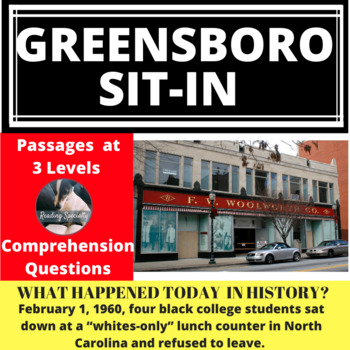Greensboro Woolworth's Sit-In Differentiated Reading Comprehension Passage Feb 1
- PDF
Also included in
- 29 Nonfiction Topics, 3 Differentiated Levels for Each, 435 QuestionsCheck out the 31 nonfiction passages, differentiated for the students in your classroom! These high-interest passages build important background information and give practice with standardized testing questions and important readinPrice $29.00Original Price $87.00Save $58.00
- Differentiated passages (3 per topic) related to the Civil Rights Movement allow students to read about Martin Luther King, Jr., Harriet Tubman, Rosa Parks, Brown v. Board of Education, Plessy v. Ferguson, the Freedom Riders, the Greensboro Woolworth's Sit-In, and the Ku Klux Klan. Use the questionsPrice $18.90Original Price $27.00Save $8.10
Description
February 1, 1960 four black college students sat down at a “whites-only” lunch counter in North Carolina and refused to leave. Read about the Greensboro Sit-in and its influence on the civil rights movement. Use the questions in standardized test format to check comprehension and help students prepare for high-stakes testing. Each passage contains these types of questions:
- main idea
- vocabulary
- organizational patterns
- inference
- summarizing
Nonfiction passages are based on an event which occurred on this day in history.
This passage is completely stand alone and appropriate for any day of the year. Mix and match by purchasing the topics you want or save with monthly bundles and give your students daily opportunities to develop background knowledge and improve their comprehension.
Passages have been evaluated using a minimum of 5 different readability formulas. The first passage is the most challenging, with an average reading level of 9th-10th grade. The second passage has an average readability of 8th grade. The third passage averages a 6th-7th grade level. With teacher introduction and background information, the passages have been used successfully with younger readers.
One subject for the class with differentiated passages allows the teacher to discuss, develop background knowledge, show a video clip or engage the full class yet provide for individual differences.
Students and teachers using multiple passages can assess student progress. Diagnostic charting shows teachers and students patterns of errors with main idea, vocabulary, organizational patterns, inference, and summarization. Compiling data is easy and motivating with student completed charts.
Included in the lesson:
➢ A nonfiction passage written at three different grade levels
➢ Questions over the passage for each level.
➢ An answer key
➢ A chart to monitor progress and collect data in the five assessed areas (main idea, vocabulary, organizational patterns, inference, and summarizing)
All student pages are available in the preview. Please take a look and be certain this is a good match for your students before purchasing. The answer key is only available in a purchased download.
This product is NOT editable.







